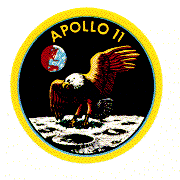Course home
page
Assignment
How did Western society benefit from the technology
developed in the Apollo Program to reach the moon?
Background
The Apollo 11 mission (Neil A. Armstrong, Edwin
E. Aldrin, Jr. and Michael Collins) climaxed the long race between the United
States and the Soviet Union to see who would reach the Moon first. The Soviets
actually launched an unoccupied spacecraft (Lana 15) to the moon three days
before Apollo 11 blasted off at 9:32 PM on 16 July 1969 from the Kennedy
Space Center in Florida.
Once the spacecraft safely reached orbit around
the Moon, Armstrong and Aldrin prepared to descend to the surface in the
lunar module (LM), the Eagle. Collins remained behind in the orbiting capsule,
the Columbia. While searching for a clear landing spot on the moon's surface
in the Sea of Tranquility, Armstrong saw that the LM's fuel was being used
too fast; he had just minutes left to land the Eagle or cut short the mission
and return without touching down on the Moon. Seeing a suitable landing site,
Armstrong brought the LM down manually. A moment later he radioed to mission
control in Houston: "Tranquility Base here. The Eagle has landed."
Apollo 11 touched down on the lunar surface at 4:17 p.m. Eastern Daylight
Time on 20 July 1969.
A little over six hours later, Armstrong—in
his spacesuit—stepped onto the surface of the Moon and uttered the
often-quoted statement that he was accomplishing a "giant leap for
mankind." In honor of the pioneers of flight, Armstrong and Aldrin
carried a tiny scrap of the Kitty Hawk, the Wright brothers' first plane.
They also carried an American flag, which they set up on the Moon's surface
and a plaque that read: "We came in peace for all
mankind."
A mishap nearly marred the astronauts' return.
One of their spacesuits accidentally broke off part of a switch that controlled
the LM's rocket. Mission control in Houston suggested using a ballpoint
pen to replace the broken switch, which worked. The Eagle left the Moon,
rejoined the Columbia and made a safe journey back to Earth, where the three
astronauts received a hero's welcome.
Timeline
-
5 October 1957, Radio Moscow announced
that the Soviet Union had successfully launched the first man-made satellite
into orbit on 4 October. The beeping device circled the Earth every
thirty-five minutes at an altitude of 560 miles.
-
3 November 1957, the Soviet Union
announced the launch of another satellite, carrying Laika, the first dog
in space.
-
31 January 1958, the U.S. launched
Explorer I, which achieved space orbit.
-
12 April 1961, Major Iurii Gagarin
(1934-68) became the first man to orbit the earth.
-
5 May 1961, the first U.S. spaceman,
Navy Commander Alan B. Shepard, Jr. (1923-) rocketed into space; Virgil I.
Grissom followed on 21 July 1961.
-
20 February 1962, Lt. Colonel
John H. Glenn, Jr. (1921-) became the first American to orbit the earth--three
times in just under five hours.
-
27 January 1967, three apollo
astronauts killed in flash fire on launch pad (Colonel Virgil Grissom, Colonel
Edward White II and Lt. Comdr. Roger B. Chafee).
-
20 July 1969, Apollo 11 (Neil
A. Armstrong, Edwin E. Aldrin Jr. and Michael Collins) landed on the moon.
Mission returned with about forty-seven lbs of rock.
WWW sites
A good starting point for a study of the Apollo
mission is NASA's Observatorium (site does not always work),
which is devoted to the study of the solar system. See the section
on
space
flight to learn how to be an astronaut and to try an interactive simulation
about space flight. NASA maintains its own home
page, as well as a specific site dedicated to the
Apollo
program (and an official page for
Apollo
11 with a variety of papers, images and resources (The
NASA
History of the Apollo Lunar Exploration Missions is an interesting on-line
history book.). The
Mission and Spacecraft
Library is a public source for information about the different types
of spacecraft, and there is also a good day-by-day
chronology
of the mission at www.historyplace.com/unitedstates/apollo11/index.html.
You can listen to Radio Moscow's
announcement
that sputnik had reached orbit; Astronaut Neil Armstrong,
declaration "That's one small step for man, one giant leap for mankind.";
or the dramatic message from Apollo 13 of serious
trouble
on-board
Very short biographies of the crew members are
available at biography.com:
Neal
Armstrong (1930-),
Michael
Collins (1930-) and
Buzz
Aldrin (1930-).
Other sites:
Recommended Books
A few interesting source materials about the
Apollo 11 mission include: Neil Armstrong, Edwin Aldrin and Michael
Collins, The First Lunar Landing, as Told by the Astronauts in a Post-Flight
Press Conference (1970); Alfred Levinson and S. Ross Taylor, Moon
Rocks and Minerals: Scientific Results of the Study of the Apollo 11
Lunar Samples with Preliminary Data on Apollo 12 Samples (1971); Apollo
11 Mission Report (1971).
A new book has appeared about the U.S. space
program: Roger Launius and Howard McCurdy, eds., Space flight and
the Myth of Presidential Leadership (1997).
Related Events
NASA
|

